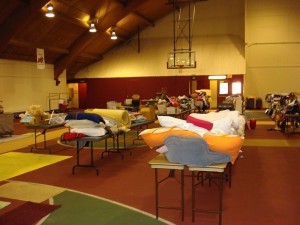Questions for Dean Manderscheid
Walking across the Oval, you might not think twice about the tall, scholarly individual walking across campus. You might totally mistake him for a professor walking to class. After all, Dean Manderscheid is a professor of mathematics, having taught for well over 30 years before becoming a Dean in academia. However, today he spends most of his time traveling around the country while also overseeing the largest and most diverse of Ohio State’s colleges, the College of Arts and Sciences. Although a humble and warm person, he holds a position of immense influence for the university — he is the visionary behind a large section of the university’s academic growth, expansion and future.
What is a college Dean? What does it take to be the Dean of Arts and Sciences, one of the largest colleges in the nation? What is this man’s deal with donuts? After sitting down in his office in University Hall, my questions were answered as I had the opportunity to learn more about the man behind “Donuts with the Dean.” I learned that the Michigan-native came to the university from Nebraska a little over a year and a half ago and that he perfectly fits in the Arts and Sciences, due to his own wide realm of interests, from the social sciences to mathematics.
It’s now the moment you’ve all been waiting for, it’s time to get to know the donut dean himself, Dean Manderscheid:
Can you tell me a little bit about what brought you to Ohio State? (Your background before becoming the Dean of Arts and Sciences?)
“Well I was Dean at the University of Nebraska at Lincoln College of Arts and Sciences for six years … I was contacted by the search firm for this position, that I’d been nominated Ohio State is always a university that I’ve looked towards at as a leader so I decided to look at this position. Before that I was at the University of Iowa for 20 years, on the faculty, starting as an assistant professor up through department chair, and so my wife and I decided to make the move here.”
How do you like Ohio?
“We love it because my wife is originally from upstate New York and I’m originally from ‘that state up north’ as they say, and so it’s closer to home for both of us.”
How is OSU different than Nebraska?
“Well Ohio State is a much bigger institution. At Nebraska there wasn’t a medical school for example, there wasn’t Vet Med, so it’s just bigger in general. The entire University of Nebraska, when I was there, was 24,000 students and here the College of Arts and Sciences (alone) is over 20,000 students, which gives you a feeling as to the size differential. The University of Nebraska at Lincoln is in a town of 300,000 and here you’re in a town of 2 million. So there’s lots of differences.”
Can you tell me about Donuts with the Dean? Was it your idea?
“I’ve always loved donuts. And so I had a tradition in Nebraska where I often brought donuts into the dean’s office, and I mentioned this to our communications staff and they said, ‘well maybe we can do something around students with that’ and so we put our heads together and came up with ‘Donuts with the Dean.'”
“Students are very fond of it, it’s become the type of thing where I will show up at Donuts with the Dean and there are already 50 students waiting to get donuts and we tweet out the location just the day of, so it’s incredible.”
What is your favorite donut?
“A buckeye donut of course (laughing). But we tend to use glazed, because everyone seems to like Buckeye Glazed.”
Can you tell me about the event “Win the Dean’s Money” that took place right before Spring Break?
“That’s something that I started at Nebraska but I just carried over completely, the only change was we asked students to write essays at Nebraska, here they just have to do a tweet and follow me on twitter and have to hashtag ‘Win the Dean’s Money’ or something like that.”
Why did you choose to engage with students on both of these forums?
“Social media fascinates me, because I see that’s where the future’s headed and it changes so quickly. And so, for example, when Twitter first came out people said, well you can’t say anything in 140 characters, and I thought “wow, what can you say in 140 characters” and I really got into it very early on. And blogging I started early also, just because I love the idea of sharing what I love and sharing things about the university I love.”
What do you think is the most important role of a Dean?
“A Dean sets a vision for a college, and where is the college headed. For example, what are the new majors that will be attractive to students. For example we started a neuroscience major recently and now over 800 students are enrolled, we started a data analytics major that just started this year and I predict we will have hundreds of students very soon … so setting a vision and setting a program that students will find attractive.”
Are there any potential new majors in the making for the future?
“One that I can talk about is coming fall of ’16 is Moving Image Production. Years ago we used to have a film major … for an institution of our size and given the importance of video these days, its really something and a mission that I think is obvious. Our students are finding it on their own and finding it at Ohio State, but we have to make it easier for them; we have alumni very well placed in the entertainment industry, we have contacts in the entertainment industry — we should use that. They’re happy to help our students, once again this is a major for those with artistic talent, where it can pay off very well.”
You have a background in mathematics, where did that stem from?
“I’ve always been good with numbers. I was always the kid in school who was first to memorize his multiplication tables and things like that and I’ve always been fascinated with numbers. When I went to college I was a math major but I thought I’d go to law school but I was just having too much fun with math so I decided to become a math professor … I became a professor — oh gosh — 30-some years ago.”
What is a misconception that students might have about a Dean?
“Well I’m not sure they even know what a Dean does … I think students aren’t sure who a Dean is, they think of a Dean as maybe the principal, but it’s a different role.”
How is the college of Arts and Sciences different from other colleges?
“The College of Arts and Sciences is the largest college on campus. We teach over 60 percent of the credit hours at the university because we teach the bulk of general education courses, so every student on campus will take a course in the College of Arts and Sciences. We’re the college where they get their math, where they get their English, where they get there chemistry … basic subjects that are common to so many different majors.”
What is a typical day like for you?
“Well, lots of meetings, a day full with meetings. It starts pretty early, I tend to get to the office at 7:30 or 8. Sometimes I’ll have events in the evening and sometimes not. A dean’s day is pretty long, emails into the evening, but mostly meetings with faculty, with students, other administrators trying to set the agenda for the university.”
When you do meet with students, what types of issues do you normally meet about?
“I like to know whats on their minds. For example, I have a student advisory board (with about 16 students) and one of the things I asked them recently was, ‘well, we changed advising in the college, do you think it’s working? What are the things that we can improve? Or do you think we should have more students who are international? Or do we have the right number?’ Those types of questions. Really, I think student input is very important.”
Do you have any comments about the faculty you interact with at Ohio State?
“We have a very world-renowned faculty here at Ohio State but one of the things that distinguishes the faculty is that they could work many other places, some who have come to Ohio State because they felt Ohio State cared more about teaching, and that’s why they came here. That connection with the students is very strong here; the value we place on being an outstanding research institution, which we are, but also one that teaches and values teaching.”
If you could change one thing about the role of a college Dean, what would it be?
“(More) interacting with students. Fundamentally I went into being a professor to teach. As a Dean it doesn’t make sense for me to teach because of my travel schedule, and I wish I could teach more, and I do teach classes every so often … but interacting with students — it’s what I miss most about being a professor.”
**** Testament to this statement:
Instead of this being a one-way interview, the Dean spent just as much time asking me about my life as a student. We talked for more than an hour about my studies, family, favorite classes and my goals for the future.
What is your favorite part of your job in general?
“Oh, feeling that I can have a positive impact on education in particular students … I work long hours but I really see the benefit when I hand a student their diploma and see how happy they are … graduation is my favorite time of year.”
I noticed you said you took a lot of social science course in addition to your mathematics, do you think these interests help you with your role in the diverse College of Arts and Sciences?
“When I was an undergraduate I was in a special program at Michigan State where I could take any courses I wanted as long as my advisors or faculty members signed off on it so I took courses all over the place … and I feel like I’m doing that again now. Because I talked to a chemist one day, I talked to an English professor the next day, I talked to a linguist the next day, and I just have this, it just satisfied my intellectual curiosity which I haven’t lost, in fact it’s gotten stronger, so that’s why I think, in part, I make a good Dean for the College of Arts and Sciences, that intellectual curiosity — I’ve never met a subject I didn’t like.”
Do you have any upcoming events?
“The April ‘Donuts with the Dean’ is coming up. What I like about the April one is hopefully the weather is warm enough so we can set up outside.”
Do you have any goals for your college in the future?
“(To be the) best College of Arts and Sciences in the country, period. As simple as that. This college used to be five separate colleges that were put together in 2010, so (it’s) the idea is we are one of the largest colleges of arts and sciences in the country and we’re one of the best, now let’s use our size to be the best. So let’s do things to cut across boundaries … Departments on campus are kind of artificial things set up based on what was important hundreds of years ago sometimes, so let’s find out what’s important now and build on what we have to get there. It’s not that the traditional departments are unimportant, its just that there are other things that are important now too.”
Do you have any advice for students regarding their academic career/experience?
“Meet lots of people, take some chances, don’t do anything crazy but take a course, maybe take an anthropology course, you might not even know what anthropology is but you might like it. Take some chances in the courses you take and the people you meet, get outside your comfort zone every so often. Another bit of advice I’d like to give students: get to know your professors. They may look scary but most of them will want to talk to you because they’re passionate about their subject and if they see you’re passionate about it too, they’ll want to talk to you.”
What is your favorite Ohio State tradition?
“‘Carmen, Ohio,’ the singing of ‘Carmen, Ohio.’ You know, I didn’t get it until I first saw it… I knew it was a great tradition and it took me a while to see how important it was but now I just think it’s fabulous … I mean very few schools have an alma mater that everybody knows, and sings … I mean, I even know it now. I still remember, it was my first month or two on the job and I was at an Alumni Event in Los Angeles, and just seeing the alumni sing ‘Carmen, Ohio,’ — bam — it’s like they’re back on campus immediately.”
Is there anything you wish the student body knew about you, and if so what would it be?
“I love Ohio State just as much as they do.”



















